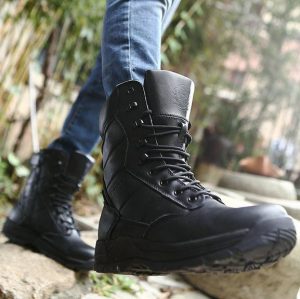When you’re looking for good quality tactical boots, tough materials and rugged build are some of the things you shouldn’t compromise about. No matter if you’re getting the tactical boots for your job or for fun, the tactical boots are supposed to keep you dry and comfortable, no matter for how long you’re out there.
Whether you’re in the rain for a couple of minutes or fighting your way back through some creek beds, the tactical boots need to take you nice and dry right until the end of everything. Are waterproof tactical boots a must have, or water resistant boots are going to cut it too? Are they the same thing, in the first place?
Know the difference between water-resistant and waterproof materials
In a nutshell, it’s all about how much protection you get in your boots from water and moisture altogether. Waterproof tactical boots are going to block water and moisture seeping through and wetting your feet. On the other hand, water-resistant tactical boots are only going to slow down the amount of time it takes the water to get inside the boots.
Knowing exactly where you’re going to go and how the chances of rain/water looks like has a big say when shopping. Nevertheless, you do want your tactical boots to be waterproof, just to minimize the risk for getting your feet all wet when in the line of fire.
Are all waterproof materials the same?
There is more than just one type of waterproof materials that is used for the tactical boots. Some boots come with the base made of water-resistant materials, but they’re over layered with other materials for better protection against water.
Spray on-coating isn’t going to cut it on a pouring day. These waterproof materials are typically heavier so they present higher endurance to pressure. You may even find tactical boots that are insulated, keeping your feet warm and dry at the same time. Some boot manufacturers are developing materials that ensure high foot protection.
Gore-Tex is an example of this and it keeps water out from the inside of your boots, while providing good breathability. Gore-Tex is amazing as it lets the vapor filter out from the inside of the boots, improving perspiration and keeping your feet dry and comfy. Keep in mind that the outer part of the boots may not always be waterproof.
Some tactical boots feature polyurethane inserts that provide moisture protection. As you know, you can get your feet wet not only from the water outside, but also from the moisture inside and polyurethane inserts make it as an effective synthetic barrier that is lightweight and long lasting, altogether.
Does waterproof come with a twist?
Manufacturers of waterproof boots are always creating and developing new waterproof tactical boots. Finding waterproof tactical boots that are also flexible and comfortable isn’t easy and you may find yourself in a pickle when you’re determined to get everything.
Some brands may impress us with their ability to keep water from getting inside the boots, but disappoint when it comes to the moisture, sealing it inside of the boots. You don’t want your feet to get all sweaty, as you’re exposing yourself to various health problems caused by various bacteria growth. you want your tactical boots to also allow perspiration so that your feet are also healthy, not only dry and comfy.
One may wonder why aren’t tactical boots so common. Truth be told, you don’t need to use waterproof tactical boots all the time. After all, while you’re in the plain desert, you don’t want to add to your list soaked and sweaty feet, especially if the chances for a rainy day are none.
Here are some things to consider when you’re looking for waterproof tactical boots:
- Weight
As these boots are rugged and made with tough and thick materials, they may not be the lightest tactical boots out there.
- Flexibility
This is another downside to consider when looking for waterproof tactical boots. The higher the waterproofness, the thicker the materials and this means less flexibility for your feet. Waterproof tactical boots may reduce not only your comfort, but also speed, balance and agility.
- Price
The waterproof tactical boots are going to make you open up your wallet, especially if you’re aiming for the high quality. A more performant material for your tactical boots does mean a higher price tag, for sure.
- Comfort
Waterproof, thick and heavyweight, the materials on the waterproof tactical boots are clearly not the most comfortable ones. But, when you want to stay nice and dry, you should be willing to pay the small price.
Take a look at the outsoles too!
No matter how much you’re valuing the waterproofness of your tactical boots, it becomes useless if you’re slipping in the very first puddle of mud that you’re walking on. The outsoles of your tactical boots is something you never want to overlook so here are some tips to keep in mind:
- Outsoles on the tactical boots should be made of rubber compound or urethane in some situations
- You can find the waterproof outsoles in a nice variety of thickness. They’re made with the same types of materials used for the outsoles of the water-resistant boots.
- Stability and good grip is something you always want on your tactical boots and the outsoles should be made of slip-resistant materials that don’t allow moisture in through the bottom.
Always check the labels
Most tactical boots come with waterproof or water-resistant labels. You should also look for the words in the product description if you’re going online for shopping. A tag inside of your boots should let you know if they’re only water-resistant or they’re waterproof.
Most water-resistant tactical boots are made of leather, nylon and various materials for coating. On the other hand, the waterproof tactical boots are made with neoprene, rubber, vinyl, polyurethane or nylon.
If your tactical boots don’t feature a label regarding their level of protection against water, chances are they’re not at least water-resistant, not the mention waterproof.









